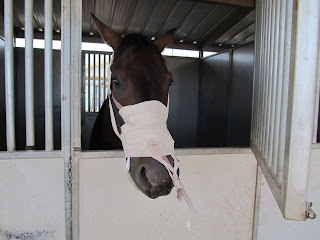Trying to keep warm bodies in our horse detachment seems to get harder and harder each year. We try to hold one riding school a year to keep our numbers up, but this year things have gotten so bad that we had to schedule a second riding school. Fortunately, we got six recruits this time, which gives us a chance of filling some holes in the roster. Unfortunately, summertime is the worst time of year to have a riding school here because of the daily thunderstorms. We have had four riding sessions scheduled the last couple of weeks on Tuesday and Thursday evenings and two of them were rained out.
The first session was what we call "ground school," where we teach the students how to groom and care for their horse and how to maintain their tack. The second session was supposed to be about how to put the tack on the horse and what the basic military commands are for riding. However, we had a really intense rain storm just before the class which soaked all the horses, so we were limited to marching around in the mud on foot. We were able to teach the basic commands and column movements, but it's just not the same without an obstinate, misbehaving horse beneath you.
Our third session was supposed to be mounted column movements, but this session was completely rained out, so we had to delay that training until the fourth session and then added another session on Saturday. So, the first night of riding did not occur until the fourth session, when finally, we got a break in the weather.
In the fourth session, we spent a great deal of time on how to place the tack properly, with extra emphasis on saddle placement. There is a tendency for new riders to place the saddle too far forward, where it interferes with the movement of the horse's shoulder. This, in turn, causes the saddle to sit high in front, distorting the rider's seat and causing the horse's back to get sore. We also go over the differences in the behavior of each of the horses during grooming; the horse that doesn't like the bit, the cinchy horse, the horse that sets back, the horse that stomps his feet down, the head-shy horse, etc. Since the students are issued a different horse each time, they soon learn all the specific techniques for handling and tacking up each horse in the herd.
After we finally got saddles on all the horses, we put the students in the practice arena and practiced mounting and dismounting in the military fashion. Fortunately, all the students in this class are in reasonably good shape and were able to get on and off their horses without any serious problems. We then had them practice side-passing and backing up. This part was a little more amusing as the horses, realizing they had newbies on their backs, were pretty much doing everything but what they were supposed to be doing. But, this is part of the horse's job. If the horses were perfectly behaved, the students would learn nothing. The horses teach the students to get their cues right and to be confident in what they're doing. You can tell by the expression on the faces of the horses and the occasional, exasperated sigh, that they know they are dealing with new riders. It is amazing to see.
All in all, the first riding session went well. The second one went even better, but I'll discuss that in my next post.




